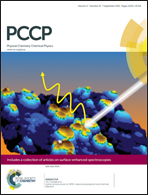Different behaviour of molecules in dark SERS state on colloidal Ag nanoparticles estimated by truncated power law analysis of blinking SERS†
Abstract
For single colloidal Ag nanoaggregates, covered with either large or small amounts of citrate anions, blinking surface-enhanced Raman scattering (SERS) of anionic thiacyanine was measured and analyzed by a truncated power law. The power law without and with an exponential function reproduces a probability distribution for bright and dark SERS events versus their duration times, respectively. On the Ag surface, except for junctions of the nanoaggregate with a large or small amount of the citrate anions, two-dimensional fast or one-dimensional slow random walk of the anionic thiacyanine, respectively, was estimated by the exponents and the truncation times in the power law for the dark SERS events. In addition, the power law exponents for the bright SERS events were derived to be of similar values, indicating a similar molecular random walk near the junction, which may be dominated evenly by a surface-plasmon-enhanced electromagnetic field on the same-sized Ag nanoaggregate. Thus, not only the bright SERS, but also the dark SERS molecular behaviour on the Ag surface was investigated by the truncated power law analysis.

- This article is part of the themed collection: Surface-enhanced spectroscopies

 Please wait while we load your content...
Please wait while we load your content...